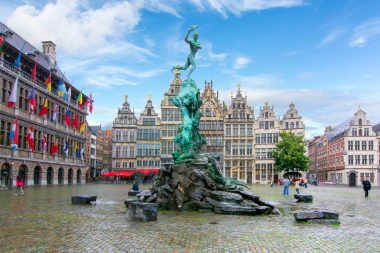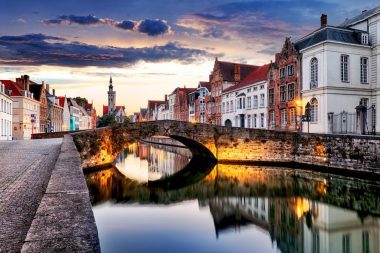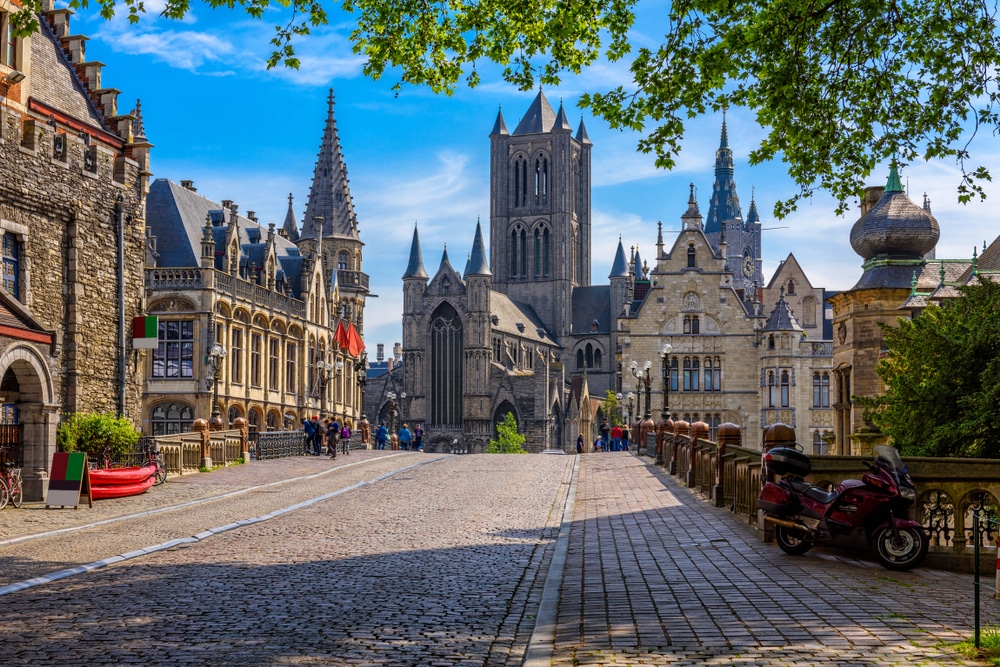Flanders is the northernmost of the three regions of Belgium and is also known as the Flemish Region. In the west, Flanders is bordered by the North Sea. The Flemish Region shares its northern and eastern borders with the Netherlands. So it is hardly surprising that the official language of Flanders is Dutch. Although the Belgian capital Brussels is a region in its own right, it is geographically located in the southern part of Flanders. Thus, a visit to the well-known EU city can be excellently combined with a holiday in Flanders.
When is the best time to travel to the Flemish Region of Belgium?
Flanders has a temperate, maritime climate. The Flemish winter is rainy and comparatively mild with temperatures averaging 5 to 10 degrees Celsius. The summer months in Flanders are usually pleasantly warm, but rarely hot. The water temperatures of the Belgian North Sea are cool and rarely reach more than 18 degrees Celsius, even in midsummer. A nice time to travel to Flanders is the sun-drenched early summer. In general, the months of May to September are recommended for a holiday in Flanders.
Holidays on Belgium’s North Sea coast
Wide sandy beaches and imposing dune landscapes adorn the almost 70 km long North Sea coast in western Belgium. Lifeguards monitor the Flemish beaches and promise passengers safe bathing in the sea. The Belgian North Sea coast can be explored particularly beautifully on a ride on the coastal railway. The longest tram line in the world runs from Knokke-Heist in the north of Flanders to Belgium’s western point to De Panne.
The seaside resort of De Panne, with its extensive sandy beach, is popular with active holidaymakers and families alike. De Panne is located in the middle of a 340-hectare dune area and offers excellent opportunities for walking, hiking, mountain biking and horseback riding. Among the busiest holiday resorts on the Belgian coast are Blankenberge and Ostend. Here, holidaymakers will find numerous restaurants, bars and leisure facilities. Lombardsijde, on the other hand, is more tranquil, where only a few international tourists spend their holidays.
Flanders’ most beautiful cities: Antwerp, Bruges and Ghent in brief

The medieval port city of Antwerp is known as the world capital of diamonds. In the diamond district of Antwerp, which is only about 1 square kilometre in size, travellers can buy rough diamonds and fine jewellery at favourable conditions. In addition, Antwerp is known as the home of the Baroque painter Peter Paul Rubens. The Rubenhuis invites you to visit the former home and workplace of the world-famous painter and marvel at some of his most important masterpieces.
Four other works by Rubens can be admired in the Cathedral of Our Lady. In general, a visit to the Cathedral of Our Lady is highly recommended: The north tower of the church, built of sandstone, has been declared a World Heritage Site by UNESCO. It proudly rises 123 meters into the sky. Not far from the Church of Our Lady is the beer pub Het Elde Gebod, where guests can taste the different types of Belgian beer surrounded by figures of saints.

West Flanders’ capital Bruges is a UNESCO World Heritage Site and enchants its visitors with its medieval flair, cobblestone streets and canals that invite you to take boat trips. A magnificent view over the Flemish city is offered from the Belfry Tower, which is considered the symbol of Bruges. In the Chocolate Museum of Bruges, visitors can learn everything they need to know about the history of Belgian chocolate production. Art lovers are recommended to visit the Groeninge Museum . Here you will find impressive exhibits from the Baroque, Renaissance, Realism, Neoclassicism and modern times.
Ghent is considered one of the best insider tips for city trips in Europe. In the Middle Ages, the city was one of the most important metropolises in Europe. Today, Ghent is a lively student city. The landmark of Ghent is the Gravensteen moated castle. Interesting is the extensive collection of historical torture instruments that can be admired when visiting Gravensteen. Another well-known sight of Ghent is St. Bavo’s Cathedral. Ghent’s oldest parish church houses the famous Ghent winged altar, which depicts the worship of the Lamb of God. A must for street art fans is a visit to Ghent’s graffiti alley Werregarenstraat. Constantly changing works of art by creative spray artists can be discovered on the concrete walls of the 100-meter-long street.
Food and drink: Flemish specialities
Shared meals with family and friends are very important to the inhabitants of Flanders. Accordingly, a lot of emphasis is placed on high-quality preparation of the food. Even the famous Belgian fries are not just ordinary fast food, but are prepared tastefully and with a lot of love. The tasty Vlaamse Frites, as the fries are called in Flanders, are popular with locals and holidaymakers alike. Flemish cuisine is known for its hearty meat and fish dishes. The restaurants on the North Sea coast in particular also have tasty dishes with lobster, crabs, oysters and mussels on their menus. The Flemish national dish is the soup Waterzooi. Traditionally, this consists of soup vegetables and fish. Today, however, Waterzooi is also often prepared with chicken instead of fish. For lovers of desserts, the Flemish butter waffles are popular, which can be eaten as a dessert or with coffee.
Flanders is chocolate country. Belgian chocolates are popular all over the world, both because of their wide variety and because of their high quality. In addition to classic chocolate varieties, exotic varieties – for example with hemp seeds, dill or wasabi – can also be tasted in Flanders. Just like Belgian chocolate, Belgian beers have also made a name for themselves internationally. There are around 2000 different types of beer in Belgium, some of which contain exotic ingredients such as ginger or coriander and juniper berries.


